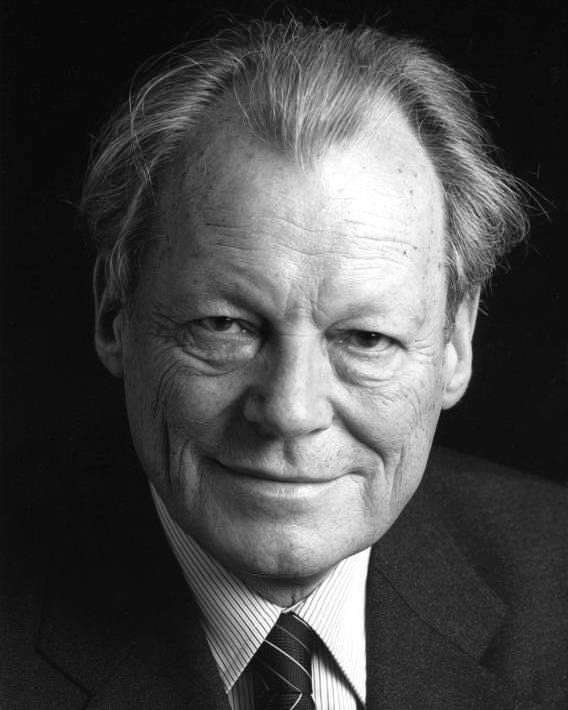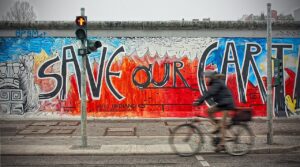As you step off the plane at Berlin Brandenburg Airport, named after Willy Brandt, they land on the very runways that once served East Germany’s Schönefeld Airport. It’s good you’re getting such an early introduction to Berlin’s history, characterized as it is by irony and symbolism taken to extremes in some cases. As your plane’s wheels hit the runway, you’re flying onto the same landing strip as Gorbachev, Honecker and other Communist luminaries. The new terminal you disembark at, however, is named after Willy Brandt, a man who as West Berlin’s mayor, fought against the regime whose runway you just used, and in his own way helped bring the system down. So who was Willy Brandt and what was his connection to the city?

Willy Brandt
Av Engelbert Reineke/Das Bundesarchiv.
Lisens: CC BY SA 3.0
From Exile to Berlin’s Mayor
Born Herbert Ernst Karl Frahm in Lübeck in 1913, the man who would later be known as Willy Brandt had an extraordinary journey to Berlin’s mayoral office. After Hitler’s rise to power, Frahm, an active socialist and member of the Social Democratic Party (SPD), fled to Norway in 1933. He adopted the pseudonym «Willy Brandt» to evade Nazi persecution, a name he kept for the rest of his life. During World War II, he worked as a journalist and political analyst, opposing the Nazi regime from exile.
After the war, Brandt returned to Germany as a Norwegian citizen, reporting on the Nuremberg Trials before regaining German citizenship in 1948. He became an influential figure in Berlin’s western SPD and was elected to the city’s parliament. In 1957, he achieved what once seemed impossible for a former exile when he became Governing Mayor of West Berlin, a position he held until 1966.
Brandt’s Berlin: Places and Memories
Brandt’s tenure as mayor coincided with some of the most dramatic moments of the Cold War. In August 1961, the East German government, backed by the Soviet Union, closed the sector border to the west overnight, severing families, friends, and communities. Brandt became a key figure of resistance against the Wall as it took shape along the lines of the border, advocating for the rights of West Berliners and strengthening the city’s ties to the Western bloc.
His office in Schöneberg Town Hall (Rathaus Schöneberg) became the nerve center of West Berlin’s administration and a symbol of democratic resilience. Today, visitors can see this historic building at John-F.-Kennedy-Platz, where both Brandt and U.S. President John F. Kennedy delivered landmark speeches.
Brandt’s leadership was instrumental in securing aid for West Berlin, notably through U.S. support, culminating in Kennedy’s famous 1963 «Ich bin ein Berliner» speech. Brandt’s diplomatic approach helped keep the city afloat despite its geopolitical isolation.
If you’re interested in tracing Brandt’s footsteps throughout the city, it worth knowing ahead of time that Brandt lived in several locations throughout Berlin, including an apartment in Zehlendorf, one of West Berlin’s southwestern districts. Though his private residences aren’t typically open to visitors, the Willy Brandt Forum at the SPD headquarters in Kreuzberg offers exhibits on his life and political career and his efforts to maintain connections between East and West Berlin. On a deeper level, you might say that anywhere you go in the former West Berlin has memories connected to Brandt’s time in the isolated Western enclave.
Why Brandt’s Berlin Matters Today
Willy Brandt’s time in Berlin had lasting consequences far beyond his time as mayor. His steady leadership during the Berlin Wall crisis foreshadowed his later work as Chancellor, where he introduced «Ostpolitik»—a groundbreaking policy aimed at easing tensions with Eastern Europe and the Soviet bloc.
His approach, based on dialogue rather than confrontation, was symbolized by his famous kneeling gesture at the Warsaw Ghetto Memorial in 1970, a profound act of acknowledgment and reconciliation that helped redefine German diplomacy and contributed towards his earning the Nobel Peace Prize. It also produced one the great iconic photographs of the Cold War years and fueled growing debate about both the nature of, and the politics of, historical memory and the role the state plays in commemoration.
It’s worth a quick digression here to delve into Ostpolitik for a bit, as it’s probably little remembered today, but played a crucial role in getting us to where we are in Europe today. Ostpolitik, or «Eastern Policy,» was Willy Brandt’s groundbreaking diplomatic approach aimed at easing tensions between West Germany and Eastern Bloc nations during the Cold War. This was at a time of high tensions and in a world where confrontation was deemed to be the best solution to political crises.
Brandt sought, as chancellor of West Germany after he left Berlin (and arguably as a result of his time in Berlin) to normalize relations with East Germany, Poland, and the Soviet Union, recognizing that engagement and cooperation could achieve more than isolation and hostility. His policy led to key treaties, including the Moscow and Warsaw Treaties of 1970, in which West Germany acknowledged post-war borders and committed to peaceful relations.
Ostpolitik also paved the way for the Basic Treaty of 1972, which improved diplomatic ties between East and West Germany and set the stage for eventual reunification, unforeseen though that result was at the time. The policy was controversial at the time, facing opposition from those who saw it as conceding to communist regimes, but it ultimately helped earn Brandt the Nobel Peace Prize in 1971. By fostering dialogue rather than division, Ostpolitik helped reshape European geopolitics, laying the foundation for détente and, ultimately, the end of the Cold War.
Perhaps most importantly, Brandt’s Berlin story underscores the city’s remarkable capacity for reinvention. Berlin has repeatedly reinvented itself after war, division, and reunification. The resilience and pragmatism Brandt displayed remain integral to the city’s identity today.
When Brandt famously declared, «Berlin bleibt frei» (Berlin remains free), he wasn’t just making a political statement, he was articulating the spirit that continues to define the city. In an age of rising nationalism and new barriers, Brandt’s vision offers a powerful counter-narrative. His belief in building bridges rather than walls, engaging in dialogue rather than isolation, and confronting history rather than denying it remains as relevant as ever. Berlin today—open, diverse, and unafraid to face its past—stands as a living embodiment of his enduring legacy. And now you know why the city’s airport bears his name.





